A couple of sea creatures, a little girl (above, by Lorna Millen), a bison, and three dogs. That’s the mix of subjects offered up in this week’s Fabric Collage Finish Line. Quite a variety, but one thing they have in common is that they’re all pretty fantastic.
Before we get to those, however, I want to highlight two spiral quilts—very different from each other, despite using essentially the same resource for instruction. The first, by Lisabeth Bennett, was made using the new Susan Carlson Fabric Collage: Spiral eWorkshop. The second, by Sheila Marie, was made using that same Spiral Exercise included in the Fabric Collage Master Class Manual.
After years of teaching fabric collage, it’s still a pleasant surprise to me just how different and individual these simple spirals can be, reflecting the personal taste and inspiration of their makers.
In a related note, blog reader Frances Dack, commented in a recent post:
Hi Susan, I took the first 4 Thursday Night in my Studio Live! sessions. I enjoyed them so much I purchased the Spiral eWorkshop last week. Last week was my scheduled week at Empty Spools Seminars. That was obviously not possible [canceled] so I did my own Pretend Empty Spools Seminar with you. I blogged about it all last week.
Pretend Empty Spools Seminar: Days 1 and 2
I had a great time. Thank you.
I of course had to check out how Frances’ pretend week at Empty Spools at Asilomar went (my own two weeks of teaching there in March had been cancelled as well). I got a kick reading how she had set up her class—making more than the best of a shelter in place situation—complete with daily beach sounds, ready-made meals, show-and-share in the evenings, all with a bit of humor. I felt like I was there and part of her experience. I especially appreciated how she prepared her fabric palette prior to beginning. It’s a strong suggestion I make that not everyone follows—and I could see how it made for a great start in the right direction for Frances. She was a very good student and got a lovely result with her spiral project. Thanks for the entertainment, Frances!
If you have a finished fabric collage quilt of any subject that you would like to see appear in a future Fabric Collage Finish Line post, please use the link below. Take care everyone.
Submit Quilt for "Finish Line"
Lisabeth Bennett
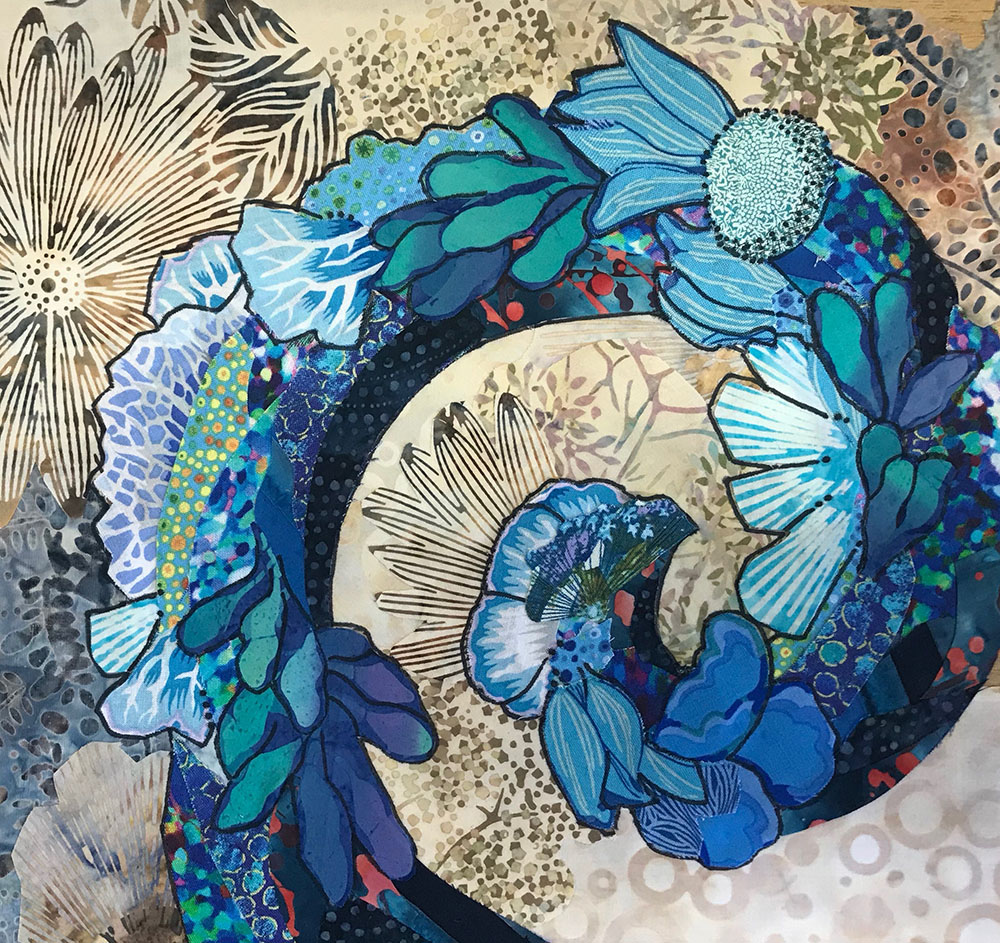
Lisabeth Bennett from Rhode Island used the Susan Carlson Fabric Collage: Spiral eWorkshop to create her seaside themed quilt. She used a nice combination of highly patterned fabrics with those of more “subtle” design—giving lots of visual texture. I love the look of the markers too.
A couple of good construction points: note how Lisabeth used X’s to mark the negative space behind her spiral so she didn’t get confused as to which spiral she was working on. Also, taking black and white photos of an in-progress piece is a good reminder as a way to help get a true sense of values as you work on a piece.
From Lisabeth:
I have read Susan’s books and do a different style of fabric collage in my own work, but thought this would be a fun exercise.
This beachy-inspired spiral was such a great learning experience. I made it small, just a partial spiral, so it would be quick. I wanted to push myself to include a wide range of values. Taking pictures as I went allowed me to convert the images to black and white to see how I was doing and control the degree to which the edges were hard and soft. After the collage step was completed I added black outlines using Marvy fabric markers because black lines are my obsession. The result was dramatic and quirky. Eventually I might quilt it up, but, for now it will live on my design wall. Thanks for a fun class!
Sheila Marie
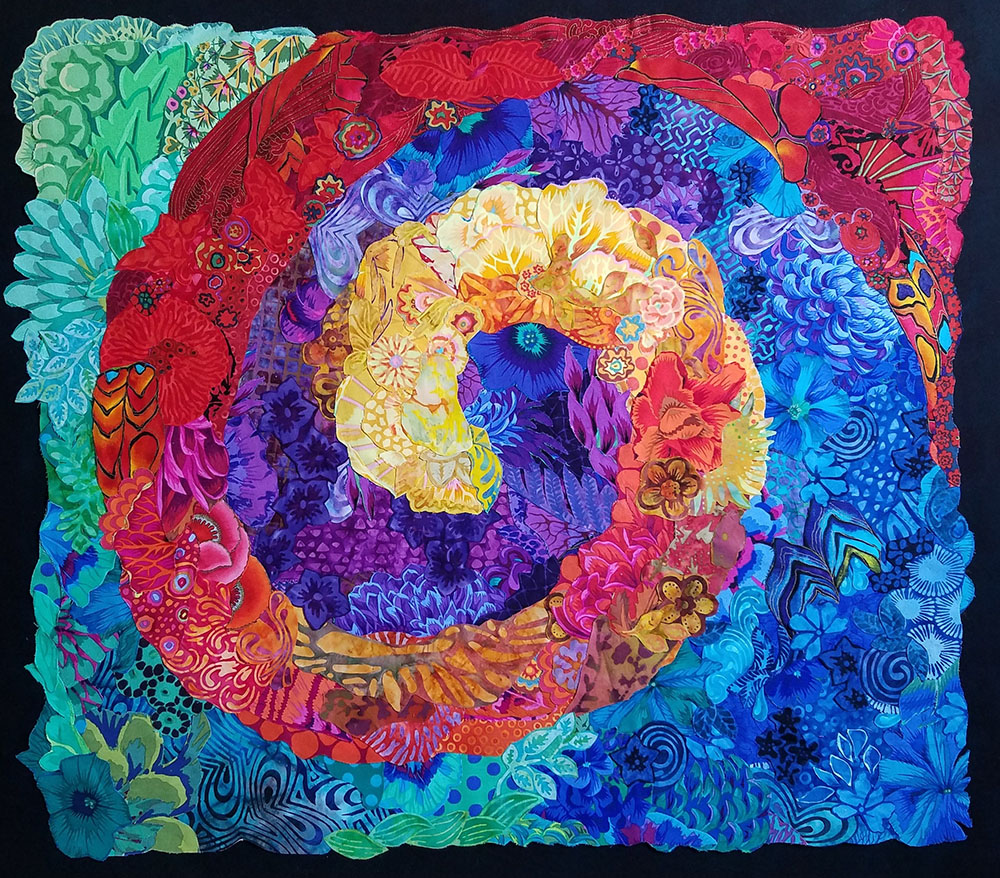
Sheila Marie from Wenatchee, WA, made her quilt from the spiral exercise included in the Fabric Collage Master Class Manual. I encourage all Master Class users to start with the spiral as a warm up. It’s such an easy and low-stress way to absorb the basic techniques of fabric collage. Not only did Marie get practice working with “warm” (yellow-based) and “cool” (blue-based) colors, but made very nice transitions from one color to the next within each spiral—with help from a nice assortments of printed fabrics. This is the sort of practice that will come in handy with future subjects.
From Sheila:
It took three tries to get into the rhythm of seeing my fabrics in a different way, and then the piece steadily evolved. I love color, and the cool and warm layout of the spiral offered contrast and a kind of rainbow effect that I liked. The toughest part to get used to was gluing, but again, once I got far enough to ‘commit’, it too became a part of the rhythm. I like the feel and look to the natural edges on all of it, so did not trim. I also did not quilt this piece. Instead it was gifted to friends as a framed picture.
Brenn Colson
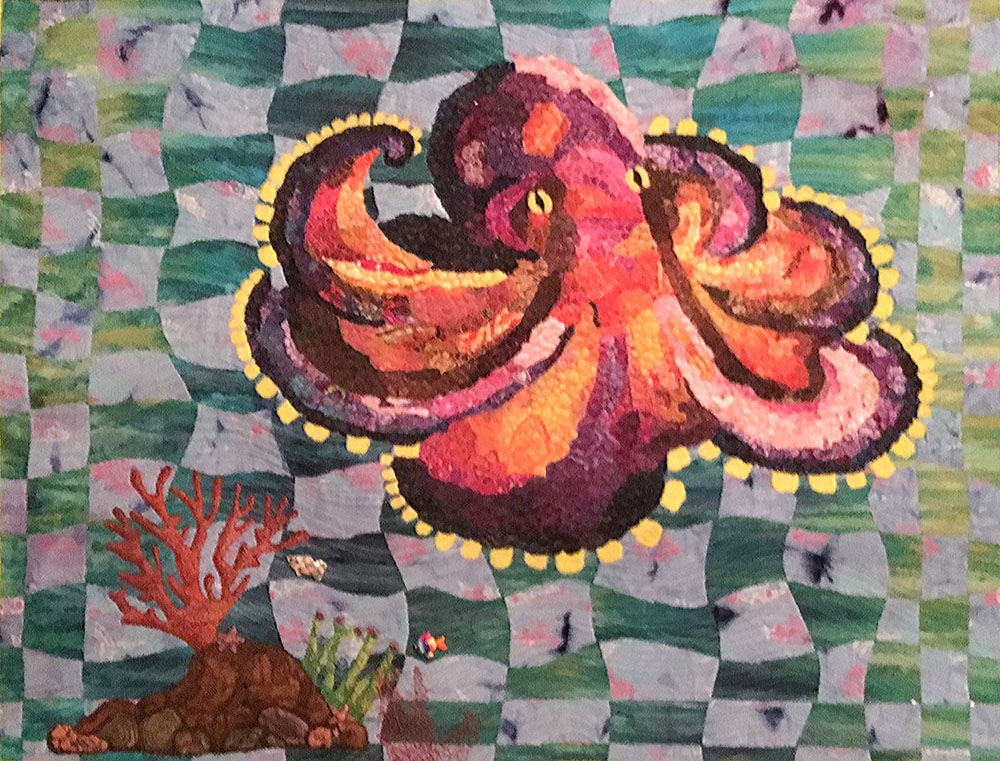
If a quilt was started in one of my classes, I have a pretty good memory of where it was begun. When Brenn Colson sent in this octopus, the visions started coming back and I knew it was from a Creations quilt store retreat in Kerrville, Texas even before Tom read me her address. I’ve taught for Creations twice, the second being in November 2013.
This octopus was pretty amazing in real life and Brenn’s particular challenge was to depict the swirling arms, like a twirling skirt, using high-contrast light and dark values for the strong highlights and shadows of the animal. I couldn’t find any in-progress photos of this beauty, but I believe Brenn had quite a bit more to finish when the 3-day class was over. Brenn, you’re “getting it” just fine—what a lovely ending. That wavy checkerboard background is interesting in that it seems to distort as the octopus drifts by, giving it movement as well.
From Brenn:
I took 2 classes from Susan. Still not sure if I totally get it! I found a picture of this octopus and was surprised by its natural colors. I enhanced it a bit.
Judi Vandervest
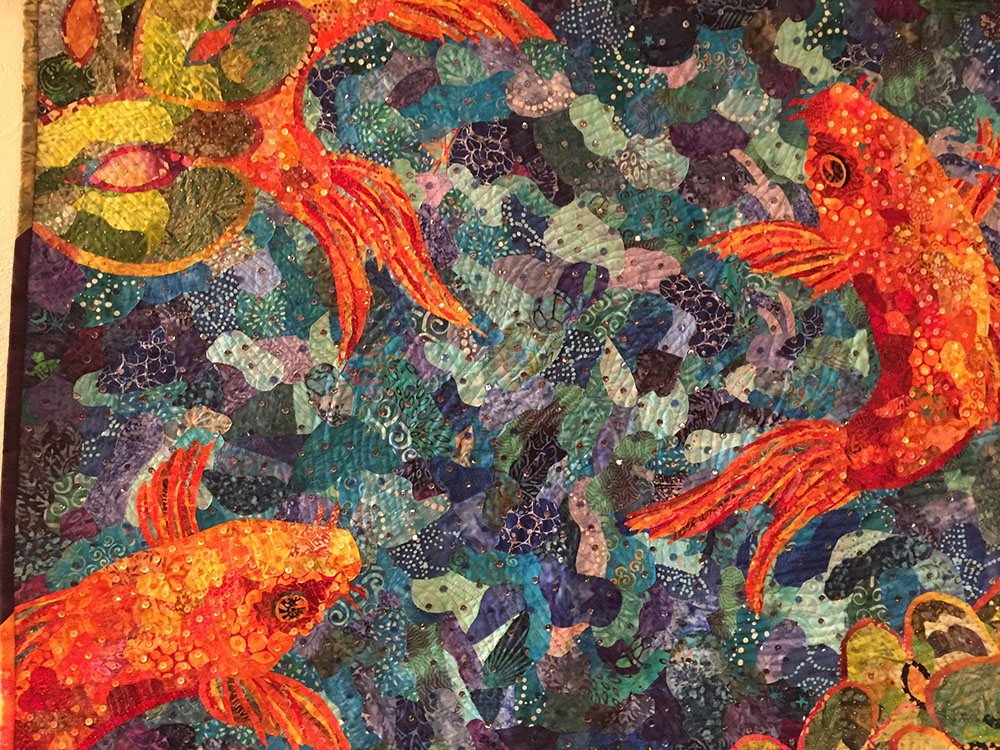
Another watery collage quilt was submitted by Judi Vandervest of St George, Utah, who used both my book, Serendipity Quilts, and the Fabric Collage Master Class Manual to learn the techniques she needed to complete her koi pond quilt. Her koi are vibrant and twist and curve beautifully through their environment. Subject matter such as this is perfect for adding some sparkle. I have a collection of glittery netting and tulle to add details like that, but Judi hand-sewed her sequins and beads—beautiful!
From Judi:
My neighbor has koi, which I take care for whenever he’s out of town. I fell in love with their grace and beauty, so I designed this quilt. I have to admit that I chose to do a bit of “Bling”on this one. The lily pads have over 500 green seed beads, the water has 5 different blue, clear and turquoise sequins, and the Koi have colors of orange, yellow, cream, iridescent and clear sequins as well as red seed beads…all hand sewn. I have three other designs on paper and will start another soon.
Lorna Millen
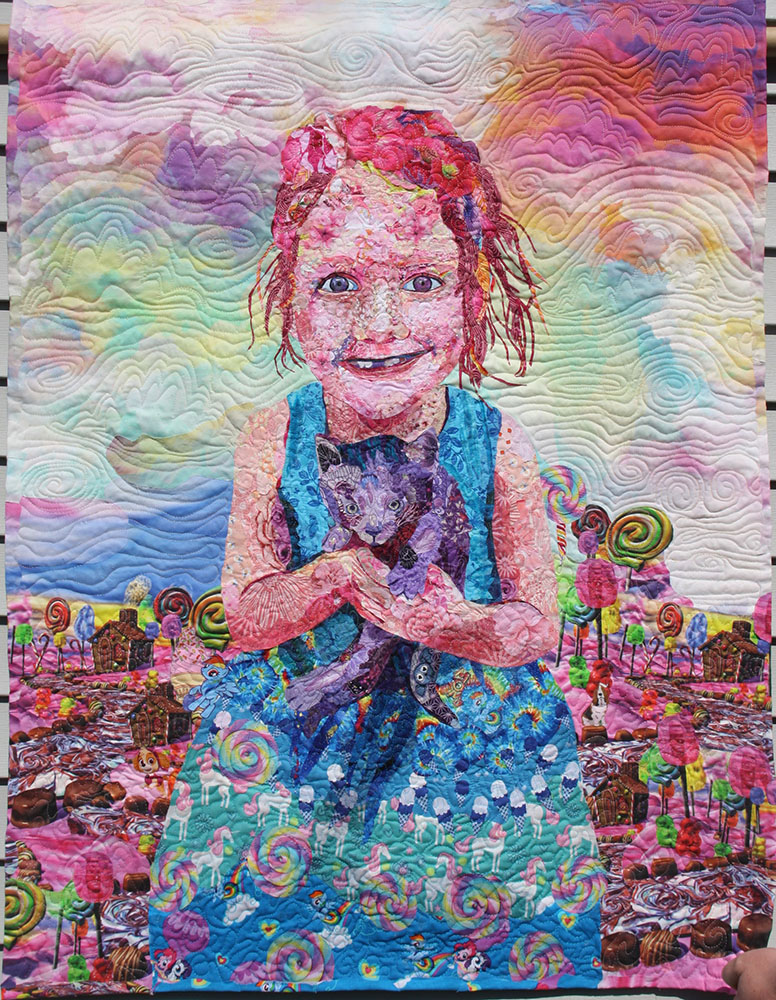
Lorna Millen from Sun Prairie, WI, attended my October 2018 class here in Harpswell, Maine. She came with her sister, Misty Cole, whose quilt of her son, “The Big Bang,” appears in this Finish Line post. They both did such wonderful portraits, capturing their children in moments unique to them. I’m now so happy to see Lorna’s quilt finished as well. Once she got that ecstatically crazy gap-toothed grin done, you knew the rest of the collage would be just as special. So fun to see it filled with sugar and spice and everything nice.
From Lorna:
This quilt is from a photograph of my daughter when she was four years old. We were at a 4th of July party, and she got to hold a kitten for the first time. I wanted to capture the joy and innocence of childhood, and encapsulate all the things that my daughter loves. My daughter picked the colors—pink, aqua and purple, which guided my fabric selection.
I started the quilt by placing different flowers for the hair. I think that choice really helped guide the rest of the quilt. I felt like I needed to make the rest of the image fit the whimsical, floral hair. My sister and I enjoyed tucking little references in our portrait quilts—mine has a unicorn eyebrow, a halloween bat, a Bassett hound in Santa hat and many more that have a lot of meaning to our family.
Susan was amazingly helpful guiding me to step outside my comfort zone with fabric choices for the skin. The class atmosphere, teaching and feedback gave me the confidence to finish the quilt on my own at home. It hangs in my daughter’s room and she enjoys showing it off to her friends and any visitors that we have.
Darlene Kihne
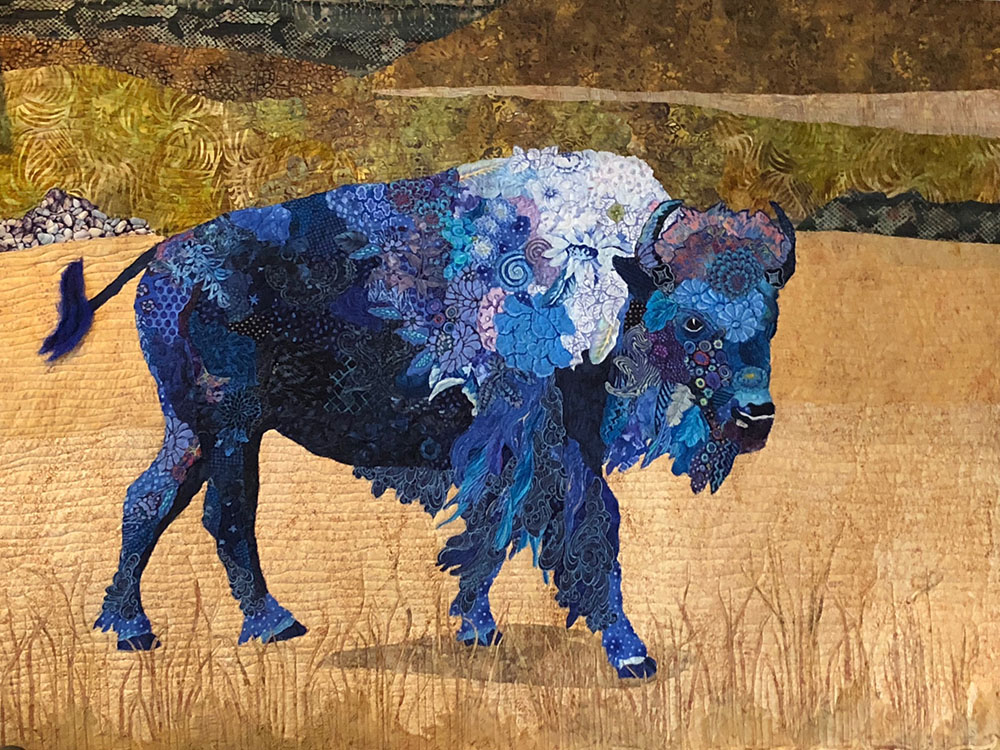
Darlene Kihne of Sioux Falls, South Dakota, has taken two classes with me, at the Wisconsin Museum of Quilts and Fiber Arts and at the Alegre Retreat in Gateway Canyons Resort, Colorado. This buffalo was begun in her first class in April 2017. From the very beginning, I loved Darlene’s use of the large patterned prints for the contours of this large sized subject—a perfect match. And look at those hairy legs and polka dot feet. Beautiful.
From Darlene:
Blue Buffalo was created using a photo taken in Custer State Park by Mike Kihne; my husband, so copyright free ðŸ‘. The inspiration for “Blue” as a color was from the dog food name Blue Buffalo.
It was a large project for first try! The background took longer for me to decide on than the Buffalo. In the end, I decided to depict the rolling hills & trees of SD Black Hills State Park.
Laura Schmidhammer
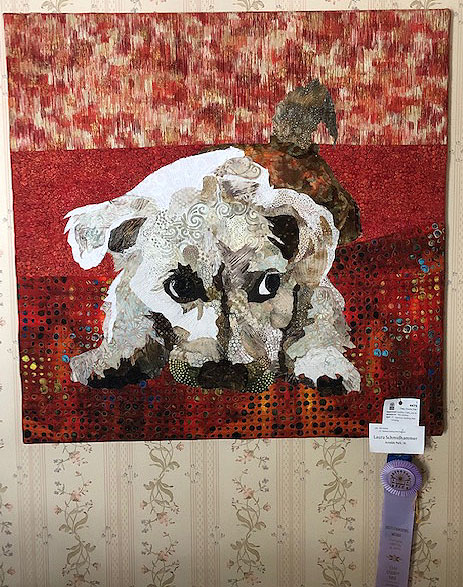
Laura Schmidhammer, from San Diego, California, is a two-time student, blog follower, and Fabric Collage Master Class user. She started the quilt above at Empty Spools in Asilomar last year. You can see the fish she started at the Flying Geese Quilt Guild of Orange County, CA in its completed state in this Finish Line post.
Laura made a big jump from colorful goldfish to white dog, but was determined to forge ahead. She got Murphy’s mischievous expression early on in class, and yes, she struggled with the subtle value changes in a white animal, but she persevered. I was glad to hear that she went on to learn more on her own about value, something I would encourage anyone who wants to delve deeper into the art of fabric collage. Like Laura says, this is like painting, just happens to be with fabric as the medium.
From Laura:
I’ve loved collage since the 60s. I discovered Susan Carlson, attended a couple of her classes, follow her blog and Master Class. The skill to transform fabrics into a collage painting with attention paid to color values is the ”˜next step’ from just having fun with colors and fun shapes.
Murphy is an unusual dog. Even as a puppy, he is planning parental domination . . . And has been successful! Of course, doing a collage of a white dog is not recommended, but he is white, so what’s another challenge!?!?!?! I started it in class, loved what we learned about eyes and the nose, but became frustrated with his ears and paws. So when I got home, I asked my textile art mentor, Desiree Habicht, for a frank review. We discovered I had developed “color value dyslexia”! I had lights where darks belonged and had broken the number one skill of seeing with your eyes, not your mind! So I ripped it up and redid it, making sure I followed my value chart and line drawing. And ended up satisfied with the results.
When I send it to Murphy’s parents, John Chapman and Wendy Wheeler, for a house warming, they sent me photos of Murphy’s approval.
Kathy Sexton
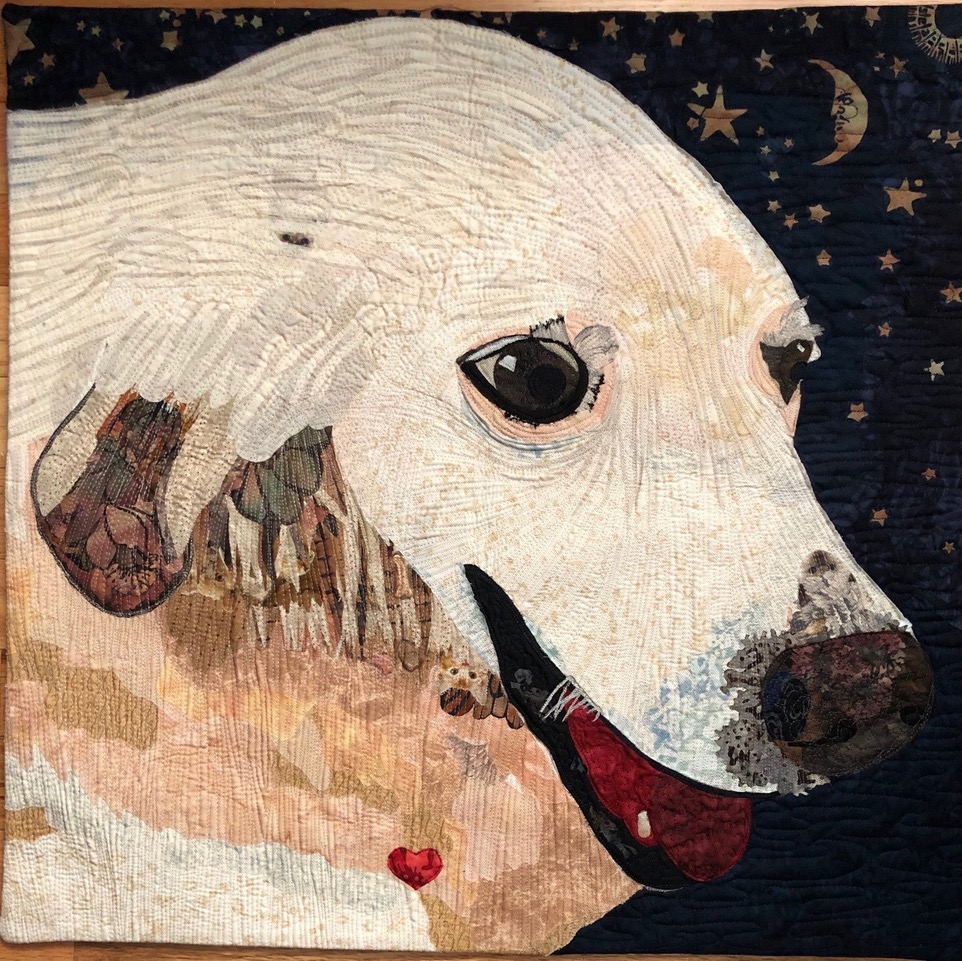
Kathy Sexton hails from Yuba City, California. Monochromatic subjects such as Marlow are a challenge. The lack of change in color and value makes it difficult to create the illusion of form. Kathy has done a very good job here with a difficult but obviously cherished subject. I was immediately drawn to the attention Kathy put into Marlow’s features. Dark eyes and noses can also be hard to depict since it’s difficult to see the details. But I can tell how closely Kathy really looked at the photo. And she’s spot-on with his smiling mouth too.
From Kathy:
I saw a presenter who had learned from you and referenced you and your book, Serendipity Quilts. I bought the book and just followed the directions. I’d taken a photo of our golden retriever, Marlow, in beautiful light, and knew I wanted to make a fabric “picture” of him, but not until I found your method, did I know how I wanted to make it.
Marlow was our English Cream Golden Retriever, and on the day he was diagnosed with Autoimmune Rheumatoid Arthritis I took a beautiful photo of him in the doctor’s office with the light shining on the side of his face. He was still alive when I made the quilt, but we lost his this past February from kidney failure due to the prednisone he was on for 2 1/2 years. He was only 8, but he’s memorialized in this quilt. I love this process and am now planning to make a portrait for some friends whose daughter was brutally murdered in Washington, DC, this summer while walking a dog. I just picked up my enlarged drawing today and got the muslin. I’m eager to begin.
Pam Milhollin
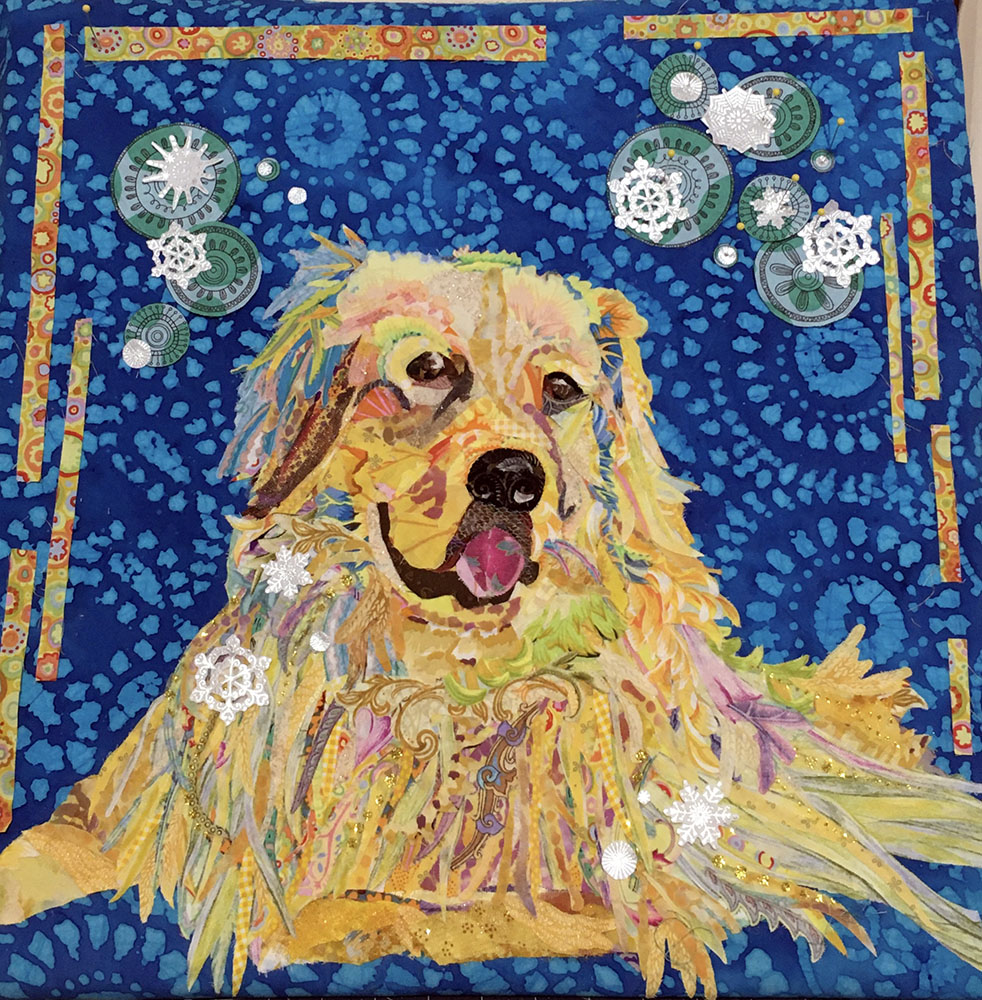
Pam Milhollin is from Parker City, Indiana. I’ve never had Pam in a class, but judging from the number of exclamation points in her write up below, I’d say she is more than moderately enthusiastic about fabric collage. In fact, she may qualify as a superfan!!!! 😉
Buddy’s portrait is another example of a great treatment of an animal’s features. Again, I can see how closely Pam examined the photo she was working from. She created eyes, nose, and mouth based what she saw, and not what she assumed was there. For instance, Buddy’s eyes are slightly different, as is his muzzle, not mirror images from one side of the face to another. Pam caught that and also added lovely “fluffy” accents to his fur using curves she found in her fabric prints. I also liked seeing her background audition photos. I think the whimsical blue was a good choice—and I’m going to make a wild guess that part of Buddy’s story is his love of the snow.
From Pam:
I have admired collage quilting for many, many years but never thought I could “do it”. Well, lo and behold! I found Susan Carlson from Facebook’s Collage Quilters! I purchased your book “Serendipity Quilts”, read ALL of your blogs, watched ALL of your videos, then purchased the Master Class! Off and running from there!
After finishing my second collage quilt, I was planning my next one – thinking of doing one from a picture of one of my granddaughters. Well, that plan changed when I saw on Facebook that my ski friends from Virginia had lost their precious golden retriever very suddenly. He was 11 years old and a very loved member of the family. I “lifted” a picture of Buddy from my friends Facebook photos and the process began.
My husband and I made the 6 1/2 hour trip to gift “Buddy” to our friends last week. They were surprised and very happy to receive the gift! Vlada, the recipient even went as far as to say it was the best gift she had ever received!!!! Well, that makes all the hours and hours of work and thought that went into this well worth it! I am now running ideas through my mind for the next one but must get my Christmas sewing completed first.
I am looking forward to 2020 being another year of collage for me as I feel I have finally found my true passion! I have been sewing since I was a very young girl and have always loved to create with fabric, but this collage thing—it satisfies all my artistic needs!
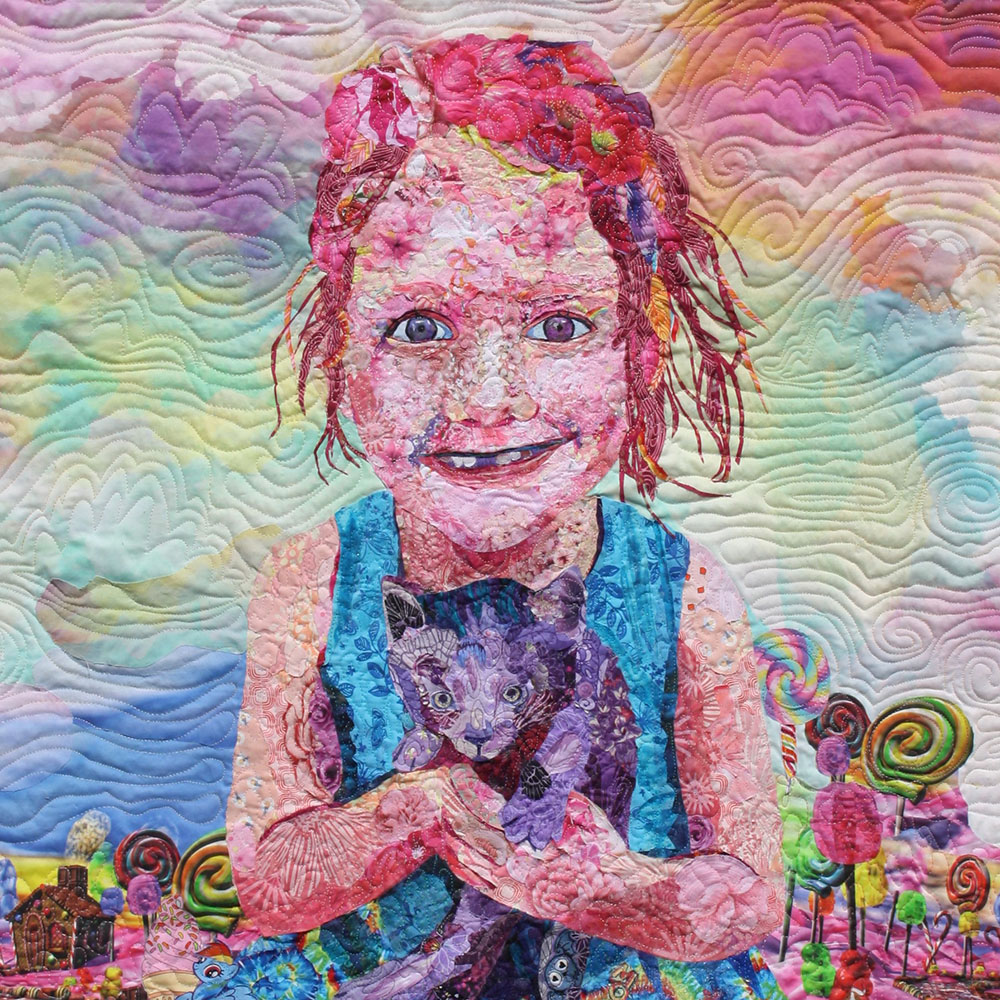

















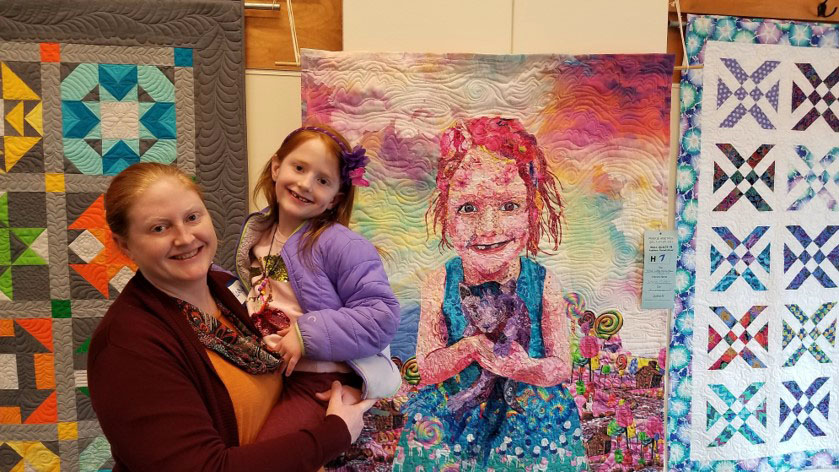
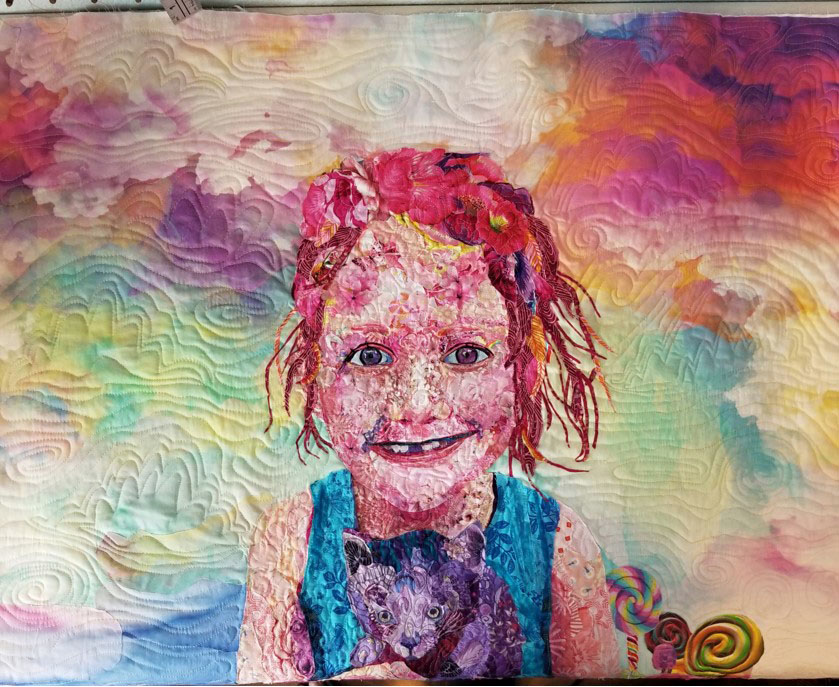


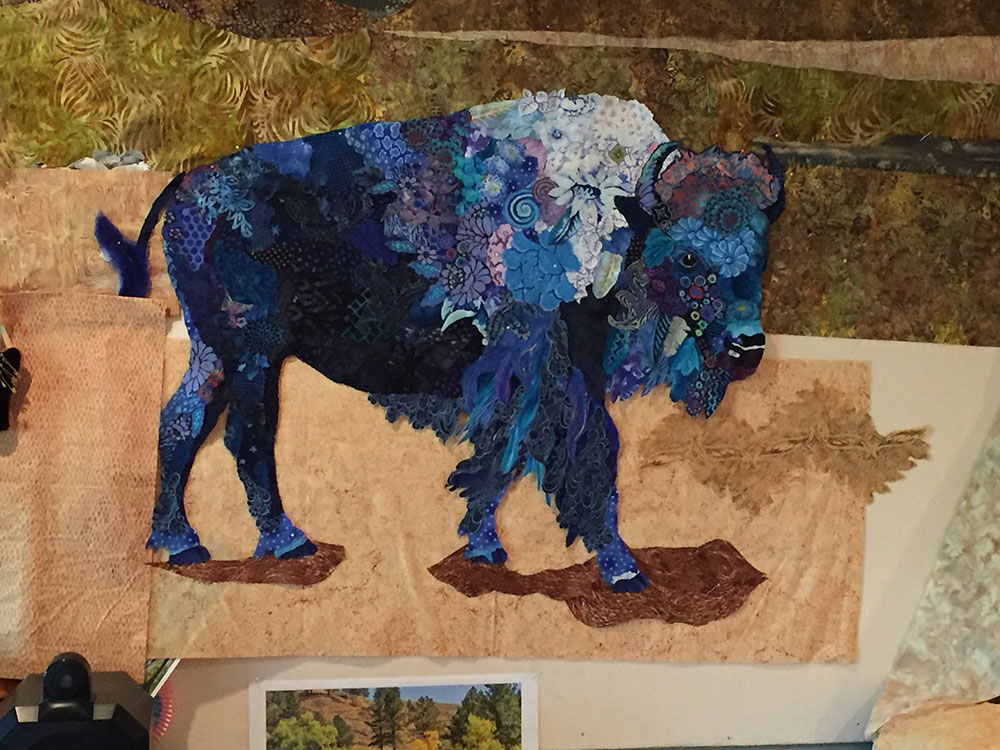


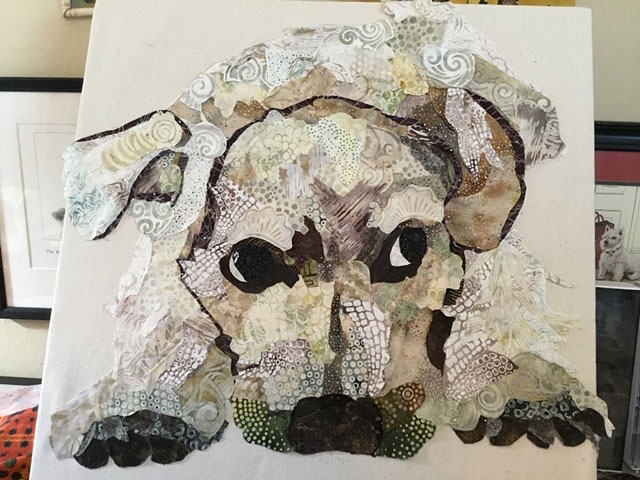
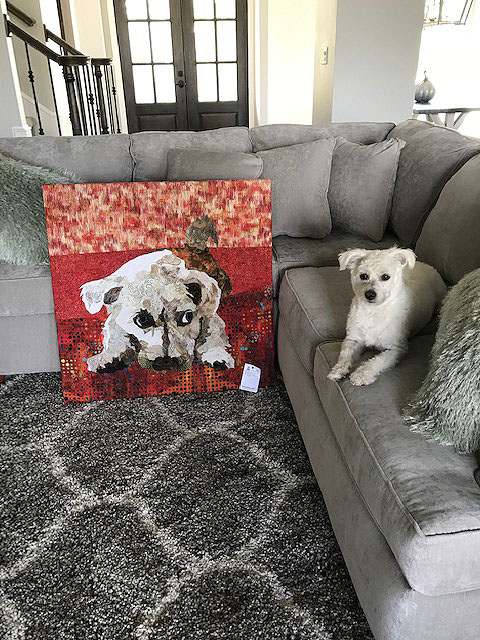








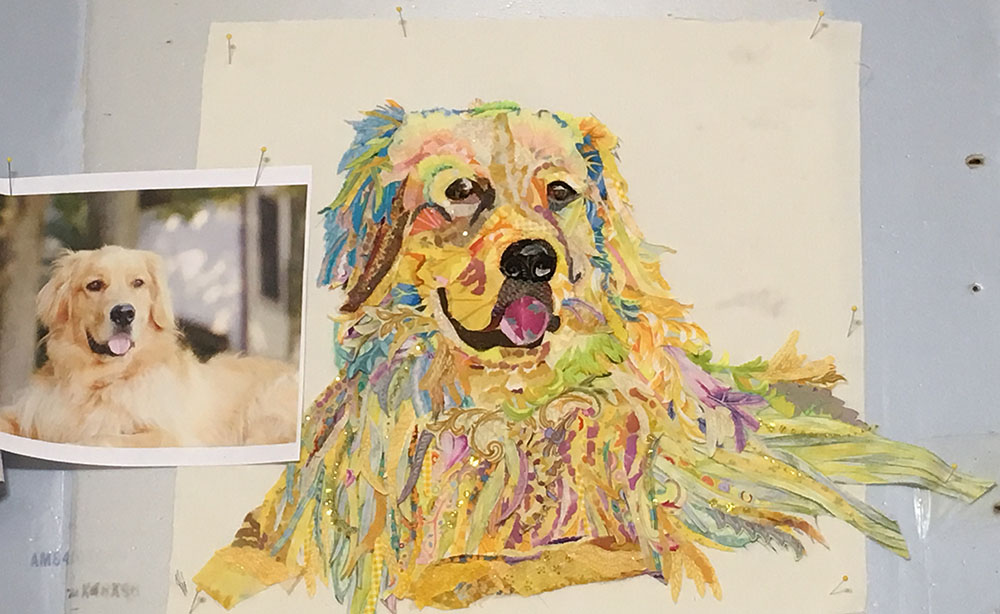




fabulous work from all the students, love them all, thanks for sharing.
Love these posts, so inspiring
These were so wonderful. Thank you for sharing, Susan. All these works are bubbling in my mind and some day may break out onto fabric.